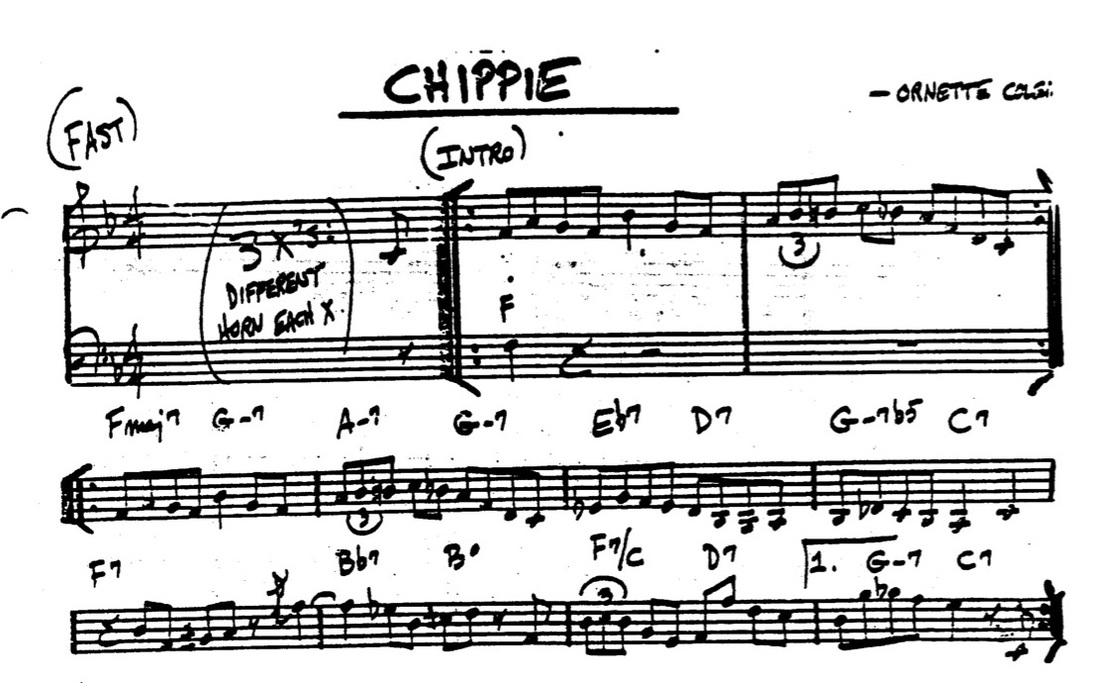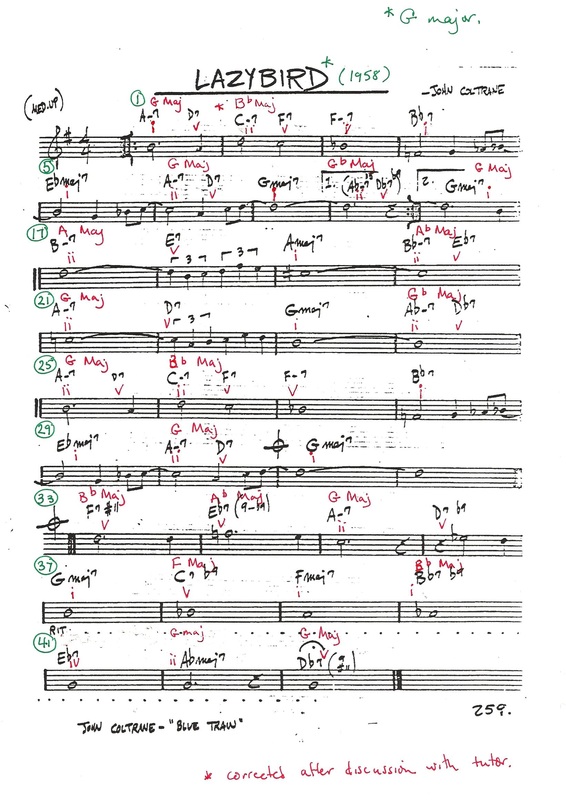While I may not be a jazz aficionado, I am interested in learning how to analyze a jazz lead sheet, comprised of the “head” (main melody) and “chorus” (chord sequence, once through).
I’m fascinated by the way jazz musicians create chord sequences first, and then fit melodies and improvisation to the harmony. As a traditional musician, I work in the opposite way, composing a melody first, and then just playing it with other musicians, hoping the guitar player will be able to figure something out! Surprisingly, some of the jazz melodies are really lovely - and would sound almost like traditional music if played slowly, with a different harmonic base. See the opening melody in Ornette Coleman’s tune “Chippie” below:
I’m fascinated by the way jazz musicians create chord sequences first, and then fit melodies and improvisation to the harmony. As a traditional musician, I work in the opposite way, composing a melody first, and then just playing it with other musicians, hoping the guitar player will be able to figure something out! Surprisingly, some of the jazz melodies are really lovely - and would sound almost like traditional music if played slowly, with a different harmonic base. See the opening melody in Ornette Coleman’s tune “Chippie” below:
Analyzing a Jazz Song - John Coltrane's Lazy Bird
John Coltrane was born in Georgia in 1926, the same year as Miles Davis, and like Davis and Honeyboy Edwards, he was the grandson of slaves. However, his maternal grandfather, Reverend William Wilson Blair* had become a religious and political leader in his community, and Coltrane was raised in a religious home. He attended a High School for African American students opened by his grandfather, and then went on to music school. He was a multi-instrumentalist, playing saxophones, horns and even the flute. In 1945 he enlisted in the US Navy, and was stationed in Hawaii where he played in the Navy jazz band. He was part of Miles Davis’ band for Kind of Blue, and is quoted on johncoltrane.com as saying”Miles music gave me plenty of freedom”. 1958, John Coltrane released his Blue Train album on the Blue Note label. It is considered to have been his favourite album. Blue Train was post bebop but pre-free jazz - I found numerous references to the style as “hard bop”.
John Coltrane was born in Georgia in 1926, the same year as Miles Davis, and like Davis and Honeyboy Edwards, he was the grandson of slaves. However, his maternal grandfather, Reverend William Wilson Blair* had become a religious and political leader in his community, and Coltrane was raised in a religious home. He attended a High School for African American students opened by his grandfather, and then went on to music school. He was a multi-instrumentalist, playing saxophones, horns and even the flute. In 1945 he enlisted in the US Navy, and was stationed in Hawaii where he played in the Navy jazz band. He was part of Miles Davis’ band for Kind of Blue, and is quoted on johncoltrane.com as saying”Miles music gave me plenty of freedom”. 1958, John Coltrane released his Blue Train album on the Blue Note label. It is considered to have been his favourite album. Blue Train was post bebop but pre-free jazz - I found numerous references to the style as “hard bop”.
Lazy Bird, the jazz song I’m going to try and analyze below, was the last track on Side 2 of the LP, was written by John Coltrane himself, and lasted 7 minutes.
Lazy Bird is in 4/4 in the key of Gmajor. The A-part is 16 bars long in total, made up of 7 bars that repeat, with different 1-bar tags for the first and second endings.
The B-part is 16 bars long, made up of a 4-bar melodic figure that is repeated a whole tone lower (8 bars), a 3-bar melodic phrase, and then a small ascending [crotchet / quaver quaver / minim] figure used three times and including a [tied quaver minim] that crosses over a bar line.
The harmonic structure is:
A-part:
Bar 1: Chord sequence is ii v of G major
*Bar 2 - 5: Transition to Bflat major with backdoor sequence ii v i
Bar 6 - 7: The key is back to Gmajor ii v i
Bar 8 - 1st ending is ii v of Gflat major with complex chords Aflat minor13 and Dflat7flat9 / 2nd ending is i of G
B-part:
Bars 17 - 19: The key has changed to Amajor ii v i
Bars 20: Change of colour using the ii v of Aflat major
Bars 21 - 23: Back to the root of Gmajor in ii v i
Bar 24: Change of colour as in bar 20 using the ii v of G flat major
Bars 25 - 32: Identical harmonic structure to Bars 1 - 8 of A-part, a very lazy bird indeed.
Coda:
I’m assuming the cross-hatched circle symbol is a a coda played before the end. If the final chord is the Dflat 7 (9 # 11), then the song finishes on a v chord, but if the final G chord is played after the end of the previous chord, then the song ends on a v i cadence.
The chords in the coda are more complex, including a #11, 9 and flat 9’s, and a 9 #11 . I don’t have the experience to really understand why these chords have been included, but I guess they add extra colour to the coda improvisation.
Bars 33 - 34: Descending key sequence: v of Bflat / v of Aflat
Bars 35 - 37: Descends back to G major ii v i sequence
Bars 38 - 42: Continues to descend: v i of Fmajor / v of Eflat major / v of Aflat major. However, Eflat7 chord in bar 41 could be a substitute for an Eflat major7 chord which would make a i iv sequence in Eflat
Bar 43: finishes with v of Gmajor
*corrected after discussions with teacher
The B-part is 16 bars long, made up of a 4-bar melodic figure that is repeated a whole tone lower (8 bars), a 3-bar melodic phrase, and then a small ascending [crotchet / quaver quaver / minim] figure used three times and including a [tied quaver minim] that crosses over a bar line.
The harmonic structure is:
A-part:
Bar 1: Chord sequence is ii v of G major
*Bar 2 - 5: Transition to Bflat major with backdoor sequence ii v i
Bar 6 - 7: The key is back to Gmajor ii v i
Bar 8 - 1st ending is ii v of Gflat major with complex chords Aflat minor13 and Dflat7flat9 / 2nd ending is i of G
B-part:
Bars 17 - 19: The key has changed to Amajor ii v i
Bars 20: Change of colour using the ii v of Aflat major
Bars 21 - 23: Back to the root of Gmajor in ii v i
Bar 24: Change of colour as in bar 20 using the ii v of G flat major
Bars 25 - 32: Identical harmonic structure to Bars 1 - 8 of A-part, a very lazy bird indeed.
Coda:
I’m assuming the cross-hatched circle symbol is a a coda played before the end. If the final chord is the Dflat 7 (9 # 11), then the song finishes on a v chord, but if the final G chord is played after the end of the previous chord, then the song ends on a v i cadence.
The chords in the coda are more complex, including a #11, 9 and flat 9’s, and a 9 #11 . I don’t have the experience to really understand why these chords have been included, but I guess they add extra colour to the coda improvisation.
Bars 33 - 34: Descending key sequence: v of Bflat / v of Aflat
Bars 35 - 37: Descends back to G major ii v i sequence
Bars 38 - 42: Continues to descend: v i of Fmajor / v of Eflat major / v of Aflat major. However, Eflat7 chord in bar 41 could be a substitute for an Eflat major7 chord which would make a i iv sequence in Eflat
Bar 43: finishes with v of Gmajor
*corrected after discussions with teacher
This is the first piece of music I’ve ever analyzed in this way, and no doubt there are better methods or language in which to do this. Lazy Bird opens with a simple melody, but It’s been interesting to find the patterns, both melodic and harmonic, which I've been unaware of just listening to the music. I’ve been surprised by the number of chords in flat keys in a song that’s in a sharp key. Analyzing the song gives me a glimmer of understanding, where previously bebop and free jazz have been pretty much impenetrable to me. It would be interesting to analyze the improvised solos in the same way, but that would be even more time-consuming and a topic for another blog (in another lifetime?!?).
*John Coltrane and Black America’s Quest for Freedom - Spirituality and the Music, edited by Leonard L. Brown, Oxford University Press, 2010. p. 146
*John Coltrane and Black America’s Quest for Freedom - Spirituality and the Music, edited by Leonard L. Brown, Oxford University Press, 2010. p. 146




 RSS Feed
RSS Feed